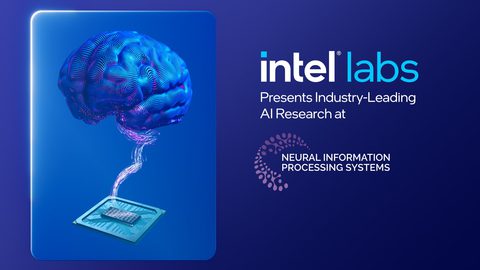TL;DR:
- Intel Labs will showcase groundbreaking AI innovations at NeurIPS 2023.
- 31 research papers presented, spanning science, climate modeling, materials science, and more.
- Highlighted innovations include brain encoding models, climate projection datasets, and efficient protein modeling.
- Multimodal generative AI techniques improve image-text retrieval and 3D video generation.
- Intel Labs leads in knowledge graph reasoning with A*Net and ULTRA.
- Intel Labs’ AI research promises significant advancements for various industries.
Main AI News:
In the fast-paced world of artificial intelligence, Intel Labs is poised to steal the spotlight at NeurIPS 2023, the premier global gathering for AI enthusiasts, developers, researchers, and academic luminaries. From December 10th to 16th, the vibrant city of New Orleans will host this spectacular event.
Intel Labs is on a mission to dazzle and inspire, sharing its visionary “AI Everywhere” concept with a diverse congregation of innovators and thought leaders. Prepare to be amazed as Intel Labs unveils a staggering 31 papers, comprising 12 main conference papers and 19 workshop papers and demos, all showcased at Booth #405. The focus of this research extravaganza spans novel models, cutting-edge methodologies, and potent AI tools for diverse applications, from advancing science to empowering climate modeling, drug discovery, and materials science.
The agenda includes a noteworthy highlight—the “AI for Accelerated Materials Discovery (AI4Mat) Workshop” scheduled for December 15th. This workshop will serve as a vibrant arena for AI experts and material scientists to join forces and address the challenges in AI-driven materials exploration and development.
Intel Labs’ research showcase at NeurIPS 2023 can be neatly categorized into the following themes, each brimming with impactful discoveries:
AI for Science
- Brain encoding models: Intel Labs collaborates with the University of Texas at Austin to introduce multimodal transformer-based models, capable of predicting brain responses, particularly in cortical regions associated with conceptual meaning—an insight into the brain’s prowess in multimodal processing.
- ClimateSet: This colossal climate model dataset, created in partnership with the Quebec Artificial Intelligence Institute (Mila), equips the machine learning community with the tools to swiftly project new climate change scenarios, setting the stage for disruptive climate-centric applications.
- HoneyBee: A state-of-the-art Large Language Model (LLM), co-developed with Mila, designed to accelerate researchers’ understanding of materials science.
Multimodal Generative AI 4.
- COCO-Counterfactuals: A groundbreaking multimodal technique for generating synthetic counterfactual data, effectively mitigating statistical biases in pre-trained multimodal models. This innovation bolsters the performance of AI models in various downstream tasks, including image-text retrieval and image recognition.
- LDM3D-VR: The Latent Diffusion Model for 3D Virtual Reality (VR) simplifies 3D video generation for AI applications.
- CorresNeRF: An ingenious image rendering method employing neural radiance fields to reconstruct 3D scenes from 2D images.
Enhancing AI Performance
- DiffPack: A game-changing generative AI method for protein modeling, ensuring that generated 3D structures faithfully mirror real-world protein properties.
- InstaTune: An efficiency-boosting technique that creates a super-network during the fine-tuning process, reducing time and compute resource requirements for network-attached storage (NAS).
Graph Learning
- ANet: Pioneering the path-based approach for knowledge graph reasoning, ANet tackles million-scale datasets, expanding the horizons of large language models and enhancing accuracy.
- ULTRA: Introducing the industry’s first foundation model for knowledge graph reasoning and a novel approach to learning universal and transferable graph representations and relationships.
- Perfograph: This innovative compiler graph-based program representation captures numerical data and composite data structures, elevating the capability of machine learning methods in programming language analysis.
For an in-depth exploration of the entire research portfolio showcased at this momentous event, delve into our comprehensive event post and watch Intel Labs’ illuminating video at the top of this page. Alternatively, visit Intel Labs at NeurIPS (Booth #405) to experience these groundbreaking AI breakthroughs firsthand.
For additional event details, be sure to visit the NeurIPS 2023 website.
Conclusion:
Intel Labs’ impressive array of AI research presented at NeurIPS 2023 signifies a significant leap forward for the AI market. Their innovations in brain encoding models, climate datasets, multimodal generative AI, and graph reasoning not only advance scientific frontiers but also hold immense promise for industries such as healthcare, climate science, and technology. The practical applications of these breakthroughs will undoubtedly drive AI’s adoption and impact across various sectors, positioning Intel Labs at the forefront of AI innovation.

